How To Generate TestNG Reports | TestNG Tutorial
TestNG Reports:
TestNG Reports come in to the picture once we execute the test cases using TestNG. Once we execute test cases using TestNG, it will generate a default HTML report. Let’s see this process of generating TestNG Reports in detail.
I have created a basic script and mentioned below.
It has three methods namely passTest, failTest and skipTest with @Test annotation.
package softwareTestingMaterial;
import org.testng.Assert;
import org.testng.SkipException;
import org.testng.annotations.Test;
public class DefaultReport {
//To make it pass
@Test
public void passTest(){
Assert.assertTrue(true);
}
//To make it fail
@Test
public void failTest(){
Assert.assertTrue(false);
}
//To make it skip
@Test
public void skipTest(){
throw new SkipException("Skipping - This is not ready for testing ");
}
}
TestNG.xml file
<?xml version="1.0" encoding="UTF-8"?> <!DOCTYPE suite SYSTEM "http://testng.org/testng-1.0.dtd"> <suite name="softwaretestingmaterial" parallel="methods"> <test name="testngTest"> <classes> <class name="softwareTestingMaterial.DefaultReport" /> </classes> </test> </suite>
Execute the testng.xml file and refresh the project. You could see your project similar to the below mentioned image.
Navigate to ‘test-output’ folder. Now you should find a report ”emailable-report.html‘. This is the default report generated by TestNG.
Open emailable -report.html using any browser of your choice. Report will be like as shown below:
You could find the complete TestNG tutorial here.
If you are not regular reader of my blog then I highly recommend you to signup for the free email newsletter using the below link.









